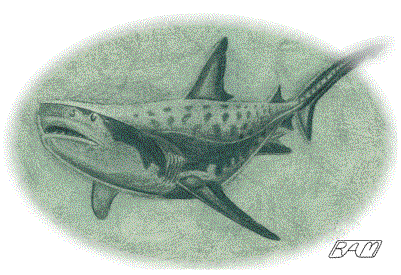Does Liver Size Limit Shark Body
Size?
The size of a shark's liver may be the key to its overall length. Unlike many teleost fishes, sharks do not have air-filled swim bladders to give them buoyancy. They are therefore heavier than water (though only by a tiny percentage) and must generate lift to prevent sinking.
Like airplanes in air, sharks 'fly' underwater, relying largely on their wing-like pectoral fins to generate dynamic lift. If the fuselage of an aircraft is doubled in size, the surface area of the wings must be more than doubled if the plane is to fly. This is because doubling in size cubes the mass of the fuselage, but only squares the surface area of the wings.
 The fin surface area of a 6.5-foot (2-metre) -long, 90-pound
(41-kilogram) Tiger Shark (Galeocerdo cuvier) is about half that of a
13-foot (4-metre), 952-pound (433-kilogram) specimen. In order to
compensate for the loss of lift caused by having a bulkier body and
relatively smaller fins, the larger shark has a liver size more than twice
that of the smaller. The liver contains light-weight oils and
hydrocarbons, which gives the larger shark the increased buoyancy it
needs. The liver of large sharks can reach great weight and contain huge
quantities of oil. For example, the Basking Shark (Cetorhinus maximus) has
an elongated body cavity filled with an enormous, oily liver which may
comprise some 20 to 25% of its total weight; up to 590 gallons (2,270
litres) of oil has been obtained from the liver of a single individual, a
29-foot (8.8-metre), 6.5-ton (5.9 tonne) specimen. In the days when sharks
were fished commercially for the oil in their livers, it was estimated
that a well-fed, 13-foot (4-metre) Tiger Shark might contain a liver that
would yield as much as 18 gallons (82 litres) of rich oil.
The fin surface area of a 6.5-foot (2-metre) -long, 90-pound
(41-kilogram) Tiger Shark (Galeocerdo cuvier) is about half that of a
13-foot (4-metre), 952-pound (433-kilogram) specimen. In order to
compensate for the loss of lift caused by having a bulkier body and
relatively smaller fins, the larger shark has a liver size more than twice
that of the smaller. The liver contains light-weight oils and
hydrocarbons, which gives the larger shark the increased buoyancy it
needs. The liver of large sharks can reach great weight and contain huge
quantities of oil. For example, the Basking Shark (Cetorhinus maximus) has
an elongated body cavity filled with an enormous, oily liver which may
comprise some 20 to 25% of its total weight; up to 590 gallons (2,270
litres) of oil has been obtained from the liver of a single individual, a
29-foot (8.8-metre), 6.5-ton (5.9 tonne) specimen. In the days when sharks
were fished commercially for the oil in their livers, it was estimated
that a well-fed, 13-foot (4-metre) Tiger Shark might contain a liver that
would yield as much as 18 gallons (82 litres) of rich oil.
Sharks obviously cannot give over an ever-larger proportion of the body cavity to house the liver, otherwise there would be no room left for other organs. One would therefore hypothesize that the maximum size for a given shark species would be limited by its maximum liver size. To date, calculations have been made only for Tiger Sharks. These suggest that the maximum length for this species should be about 16 to 20 feet (5 to 6 metres), a figure which agrees with records of the largest individuals captured. Further, these results cast doubt on a gigantic 24-foot (7.4-metre), 6 842-pound (3 110-kilogram) specimen reportedly caught off Indo-China in 1957.
